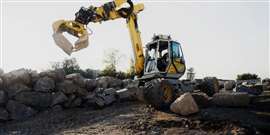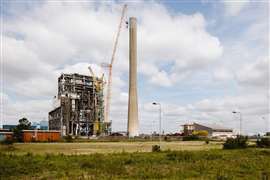Read this article in 中文 Français Deutsch Italiano Português Español
AI-powered robotic excavators take direction on site
10 June 2024
What if you could give an excavator a set CAD drawings and just let it go to work, knowing it would follow directions to within a milimeter of accuracy? Can you imagine the time, money and labor that could be saved?
Switzerland-based Gravis Robotics is developing a module for installation on individual excavators, allowing them to navigate jobsites and perform as needed, all without the presence of a human operator.
Technology like this is being seen more and more, with driverless machine concepts being shown at many of the construction industry’s premier events, such as Bauma, Conexpo and Intermat.
 Neil Woodfin, chief business development officer at Gravis Robotics.
Neil Woodfin, chief business development officer at Gravis Robotics.
Neil Woodfin, chief business development officer at Gravis Robotics, was recently at the European Rental Association (ERA) convention in Lisbon, Portugal, where he spoke about the company’s plans to bring the accuracy, safety and efficiency of robots to today’s jobsites.
Born from ‘dogs’
Gravis Robotics is a spinoff from the robotics laboratory at ETH University in Zurich, Switzerland, which is run by Professor Marco Hutter, who has been working with 25 of his PhD students to develop AI software initially intended for four-legged robotic “dogs.” Those “quadrupeds” explore environments and come back with a 3D map. (Think “Spot” by Boston Dynamics.)
“Marco decided to take that software and adapt it to excavators,” Woodfin says. “What we’ve got is a robotic module which fits onto the roof of the cab. Inside the robotic module is a CPU equipped with cameras to give it a 360-degree view and a LIDAR.”
Sensors on the excavators allow the machine to understand the position of the arm and the boom and the dipper. LIDAR provides measurement of where the machine is on site, while a GNSS sensor provides the GPS reference to the machine. As a result, the machine is able to navigate itself around the site in between its work activities.
“The robotic module learns to operate the excavator and always looks to achieve 100% bucket fill rate when it’s digging,” Woodfin explains. “It’s able to use the AI software to adapt to the heterogeneous environment it’s encountering while digging.”
He adds, “We’re very, very good at digging. What we’re looking at doing, after all of this development work, is putting robotic excavators onto construction sites by July. Then we can really understand the benefits we can achieve, which are in the area of productivity, safety, sustainability, and predictability too.”
Directing the dig
How does the excavator know what to do?
Woodfin explains that once the robotic module is installed on the excavator, it begins to learn how to operate the machine. “Then you can upload CAD drawings of the excavation work that needs to be done,” he says. “We also give you a touch-screen tablet, which sits in the cab, and you can literally draw using your finger where you want on the site, which the trench to be dug. You can type in the depth and the width of the trench, and then the excavator will use that and go off and excavate that trench.”
Woodfin explains it’s also possible to simply lower the bucket onto the ground and extrapolate measurements for an area to be excavated.
“For example, if you were doing an extension of a house, you could lower the bucket onto the ground and say, ‘I want everything from where the bucket is touching the ground to be 250 millimeters lower. And then what would happen is the excavator would show you a grid of everything that was 250 millimeters lower and everything that was either higher or lower than that. The excavator would then excavate to achieve the level you’d set just by placing the bucket on the ground.”
The only machine prerequisite for using the Gravis module is electro hydraulics.
“If it hasn’t got electro hydraulics, we put an electrohydraulic control valve onto the excavator,” Woodfin says. “Then we plug the module into the CAN bus system. So it needs to have a modern electronic system, which we would then connect it to.”
He adds, “If it hasn’t got IMU sensors, we would put those onto the excavator. Other than that, the rest of it is supplied within the rooftop automation control kit we put onto the excavator.”
Gravis is currently working with six OEMs, one of which is Hyundai/Develon, as part of a partnership announced at CES 2024 in Las Vegas in January.
“We’re working with them on automating their excavators. Within the other manufacturers we’ve got a 10-ton excavator, but the majority we’re working on are 20-ton, because that’s the most popular size category of excavator in the industry,” Woodfin says.
But can you rent one?
The next natural question is whether these robotically controlled excavators are available for rent.
“We are working very closely with construction companies and rental companies,” Woodfins says. “As manufacturers, we produce generic machines. What makes it a specialist machine is the operator. As we bring robotics to the industry, we are condemned to become specialists because we have to understand what the operator is doing.
“One of the things we found is that with the big construction companies, they’re saying, ‘well, if you could automate this task… instead of using a subcontractor, we could rent an automated machine to do that task and then bring the subcontractor in to do all the work that hasn’t yet been automated.’”
Woodfin continues, “Rental for them is seen as a great opportunity, and we are developing the number of tasks that we can automate. Today, we’re focusing on trenching and bulk earth works and truck loading. Then we’ll be moving along and adding more and more tasks to that portfolio of tasks that we can automate.”
Gravis is currently working wth Morgan Sindall and Vinci and is in talks with UK-based firms Flannery and Lynch, as well as Vesco in Switzerland. “We’ve been working with the Swiss Army and
 Switzerland-based Gravis Robotics is developing a module for installation on individual excavators, allowing them to navigate jobsites and perform as needed, all without the presence of a human operator. (Photo: LinkedIn)
Switzerland-based Gravis Robotics is developing a module for installation on individual excavators, allowing them to navigate jobsites and perform as needed, all without the presence of a human operator. (Photo: LinkedIn)
the Swiss Rail as well,” Woodfin says. “We’ve had a lot of good contact with end users and rental companies, but we want to grow that.”
When asked if one module could be transferred from machine to machine in a rental setting, Woodfin says that’s the long-term goal.
“That’s the plan. It wasn’t something we’d initially thought about, but it’s been one of the things the rental companies have requested. There’s no reason why that’s not going to be possible,” he says.
“The only thing you’d need to do is make sure that the framework for the module was already installed on each of the excavators. The robotic module does take some time to learn to operate each excavator. Once it’s learned how to operate the excavator, then it’s fine, but the AI software has to operate everything to understand how it reacts to various different controls.”
Coming this July
“In July, we want to put our module into real-life environments and then we’ll be looking to get partners on board to bring automated excavators on site. We’ve got 25 roboticists on an operational team to see how to integrate robotics into your day-to-day activities. We’ll be working closely with those people to ensure that when they need technical support, we’re there to provide it, and then we can together develop these operational models that will allow us to integrate it.”
Currently focused on the European market, Gravis has plans to expand into the Americas and Australia as well.
The price of the module is expected to be Є80,000-90,000, depending on the hardware the excavator’s equipped with. “Part of that is a recurring software cost,” Woodfin says. “We’ve tried to keep the cost as low as we possibly can.
“We recognize that we’ve got to generate value from that robotic module, so we’ve got a value calculator, which we demonstrate through increased cycle times through bucket fill rates, improved utilization rates, and the elimination of certain labor on site. We can get the recovery of those technology costs on a weekly basis.”
To help achieve its goals, Gravis Robotics is collaborating with a number of partners, including Moog Construction, the company behind many of the autonomous technologies used in construction equipment today. According to Moog Construction, it is “augmenting its expertise in precision motion control, functional safety, and integrated system design by developing automated functionality for the construction industry, while Gravis Robotics applies its expertise in sensor fusion, environment perception, advanced teleoperation, augmented reality visuals, and autonomous navigation to turn large construction machines into autonomous mobile robots.”
At Bauma 2022, Moog Construction and Gravis Robotics together equipped a Menzi Muck walking excavator with the capability to robotically dig trenches based on inputs provided by an operator from a remote location. The operator could set the trench’s length, pitch, etc., and the excavator would complete the task.
The partners believe these capabilities and more will bring the next generation of construction machines to new levels of connectivity, productivity, and safety.
STAY CONNECTED


Receive the information you need when you need it through our world-leading magazines, newsletters and daily briefings.
CONNECT WITH THE TEAM












